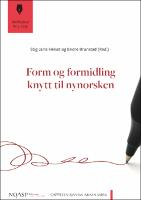Form og formidling knytt til nynorsken
| dc.contributor.editor | Helset, Stig Jarle | |
| dc.contributor.editor | Brunstad, Endre | |
| dc.date.accessioned | 2022-10-25T10:18:02Z | |
| dc.date.available | 2022-10-25T10:18:02Z | |
| dc.date.issued | 2022 | |
| dc.identifier | OCN: 1367233910 | |
| dc.identifier.uri | https://library.oapen.org/handle/20.500.12657/59050 | |
| dc.description.abstract | The starting point for this issue of Skriftkultur is the 150th anniversary of Ivar Aasen’s launch of a national language, which at the time lacked freedom of choice in form and conjugation, but has since developed, for specific historical reasons, into today’s Nynorsk, characterized by great freedom of choice compared to the vast majority of other official written languages in the world. Constant changes to the language’s orthography throughout the 20th century led to both resistance to and difficulties in implementing the reforms. Publishers and newspapers created their own house rules, and a number of studies have shown that students at all levels and even teachers have had difficulty keeping track of what is correct in Nynorsk at any given time. Likewise, students probably have greater exposure to Bokmål than Nynorsk, even in the core area for Nynorsk in Western Norway, which can create challenges for Nynorsk users. In the six scholarly articles, the authors discuss the challenges and opportunities linked to the use of, exposure to and instruction in written Nynorsk. The articles include questions related to the use of house styles in Nynorsk organisations, deviations from standard Nynorsk orthography in student texts, and exposure to and instruction in Nynorsk in educational settings. In a broader perspective, the question of Nynorsk’s continuing evolution also concerns the place and functions the language fills, that is to say, the kinds of social practices that are at the foundation of Nynorsk. This publication will be relevant for students, researchers and others who are interested in written Nynorsk practices. | en_US |
| dc.language | Norwegian | en_US |
| dc.relation.ispartofseries | Skriftserien | en_US |
| dc.subject.classification | thema EDItEUR::C Language and Linguistics::CF Linguistics::CFA Philosophy of language | en_US |
| dc.subject.classification | thema EDItEUR::C Language and Linguistics::CF Linguistics::CFD Psycholinguistics and cognitive linguistics | en_US |
| dc.subject.other | language attitudes, language awareness, language exposure, code-switching, language standardization, New Norwegian/Nynorsk, språkhaldningar, språkmedvit, språkeksponering, språkveksling, språknormering, nynorsk | en_US |
| dc.title | Form og formidling knytt til nynorsken | en_US |
| dc.type | book | |
| oapen.abstract.otherlanguage | Utgangspunktet for dette nummeret av Skriftkultur er at det no er 150 år sidan Ivar Aasen lanserte landsmålet, som den gongen var utan valfridom i form- og bøyingsverket, og at dette skriftspråket av bestemte historiske årsaker har utvikla seg til eit nynorsk skriftspråk som er kjenneteikna av stor valfridom jamført med dei aller fleste andre offisielle skriftspråk i verda. Stendig nye rettskrivingar gjennom det 20. hundreåret medførte både motstand mot og vanskar ved implementeringa av reformene. Forlag og avishus laga sine eigne husnormer, og ei rekkje studiar har vist at elevar, studentar og jamvel lærarar har hatt vanskar med å halde styr på kva som til ei kvar tid er tillatne former i nynorsk. Samstundes blir norske elevar og studentar truleg eksponerte for meir bokmål enn nynorsk jamvel i kjerneområda for nynorsken på Vestlandet, noko som kan skape utfordringar for nynorskbrukarar. Gjennom seks vitskaplege artiklar diskuterer forfattarane utfordringane og moglegheitene som knyter seg til bruk av, eksponering for og opplæring i det nynorske skriftspråket. Artiklane inkluderer spørsmål knytt til bruk av husnormer i nynorskorganisasjonar, avvik frå nynorskrettskrivinga i elevtekstar og eksponering for og opplæring i nynorsk i utdanningsinstitusjonar. I eit vidare perspektiv handlar spørsmålet om tradering av nynorsk også om kva plass og funksjonar språket fyller, det vil seie kva slags sosial praksis som ligg til grunn for nynorsken. Publikasjonen rettar seg mot studentar, forskarar og andre som er opptekne av det den nynorske skriftkulturelle praksisen. | en_US |
| oapen.identifier.doi | 10.23865/noasp.175 | en_US |
| oapen.relation.isPublishedBy | bf7b42a4-6892-42e3-aaf8-8f32c8470a8b | en_US |
| oapen.relation.isbn | 9788202779801 | en_US |
| oapen.relation.isbn | 9788202785642 | en_US |
| oapen.relation.isbn | 9788202785659 | en_US |
| oapen.relation.isbn | 9788202785666 | en_US |
| oapen.series.number | 4 | en_US |
| oapen.pages | 189 | en_US |
| oapen.place.publication | Oslo | en_US |

